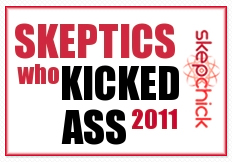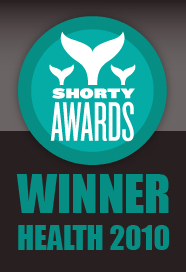Apparently this week has been MedicineWise Week in Australia.
I didn’t know this until out of curiosity I went to a website which has been heavily advertised over the last week on Australian television – the NPS website. I knew of this Australian government organisation since I follow them on Twitter but only after visiting the website did I discover they provide information on medicines for consumers and health professionals alike. Plus they are behind MedicineWise Week from January 30th – February 6th, 2011.
In light of the worldwide Ten23 campaign conducted all over the world this weekend – in fact every continent including Antarctica was represented – I thought I would pose as a consumer and search for information about homeopathy.
Like homeopathy itself, what I turned up was minimal and not very useful. I’ll explain more about this a bit later but first, as I was surfing around the NPS site, I found a press release about a survey of Australians’ knowledge of medicines.
Fifteen hundred consumers were surveyed and the results reported that 65% had used a prescription medicine in the last three months, 60% had used an over-the-counter medicine and 45% had used an alternative or herbal medicine.
When it came to alternative medicines and supplements, of those surveyed, less than half considered certain vitamins and herbs to be medicines: multivitamins (23%), echinacea (24%), fish oil (32%). Awareness of Chinese herbal remedies as medicines was slightly higher at 41%.
NPS clinical adviser Dr Danielle Stowasser said, “The first step to being medicinewise is knowing what is a medicine. Medicines include tablets, vitamins, herbs, eye drops, creams and gels. Medicines don’t just come on prescriptions but include things bought in a pharmacy, supermarket and other stores, and from naturopaths and herbalists.”
But thinking back to homeopathy, here’s where I began to get concerned:
Encouragingly, when asked where they would go to find accurate information about medicines, most respondents said a pharmacist (64%) and/or a doctor (60%). However, when asked if they did ask questions of their doctor or pharmacist the last time they received or purchased a medicine, 60% said no and 48% said they did not tell their doctor or pharmacist about other medicines they were taking.
Sixty four percent said they could get accurate information about their medicines from a pharmacist? I’m sure this is true for most conventional medicines – but I have repeatedly asked pharmacists about homeopathy and only once was I given an accurate description of what it is and what it does. ONCE. And in a certain pharmacy in Newtown, I have been (not so politely) shuffled to the door when asking too many questions of the shop assistants about homeopathy.
So, sadly in my experience, consumers cannot rely on pharmacists to accurately advise them on homeopathy.
So, I expected that a quick trip to the heavily promoted NPS website would do the trick. A search for “homeopathy” turns up one link to a generic page on complementary medicines where homeopathy is cited but not explained. A search for “homeopathic” turns up a link to a video which likewise doesn’t address homeopathy directly and in fact could even be construed as misleading. An excerpt from the transcript appears below:
“Manufacturers of non-prescription medicines sold in Australia must ensure that their products meet certain quality and safety standards, however when it comes to providing evidence of their effectiveness, they’re not tested as thoroughly as prescription and pharmacy medicines. The less thorough testing does not mean that these medicines don’t work, rather it means that the manufacturers don’t have to provide as much scientific evidence as they do for prescription and pharmacy medicines.
When you are choosing a traditional or herbal medicine obtain as much information about it and it’s use as you can.”
I doubt there would be any confusion that homeopathic “remedies” are not prescription medicines, but they could certainly be considered pharmacy medicines. After all, they are sold in pharmacies alongside the science-based remedies. So this video implies that since homeopathy – for all intents and purposes – is a pharmacy medicine, then it is tested just like prescription medicines.
Of course this is simply not true. In fact, some homeopathic remedies are exempt from the Australian Register of Therapeutic Goods (ARTG) which is a list of approved medicines and devices, because – in many cases – they are so dilute that they no longer contain active ingredients. Thus, there is nothing to regulate if there is nothing in the “medicine”.
The TGA website states homoeopathic preparations are exempt from the ARTG if :
“(they are) more dilute than a one thousand fold dilution of a mother tincture and which are not required to be sterile; and which do not include an ingredient of: a) human origin; or b) animal origin, if the ingredient consists of, or is derived from, any of the following parts of cattle, sheep, goats or mule deer.”
So unless you started with a mother tincture derived from animal or human sources, the government is not particularly interested in your product. And if it’s more dilute than 1000 times then they’re also not bothered. Makes sense I guess, since sugar pills and water with a dash of alcohol won’t do you any direct harm. (But, this does not mean they don’t do you harm.)
Even more bizarre is that when homeopathy is not sold through pharmacies, it is exempt from the TGA’s own advertising standards.
“A homeopathic product can carry claims which do not comply with the Therapeutic Goods Advertising Code and may still be listed in the ARTG. However, the label on the container and on the primary pack must include a statement to indicate that the indications have not been “approved” by the TGA.”
The description of homeopathy on the TGA website is also not very helpful to uninformed consumers.
“Homoeopathic preparation” is defined by the Therapeutic Goods Regulations as a preparation:
- formulated for use on the principle that it is capable of producing in a healthy person symptoms similar to those which it is administered to alleviate; and
- prepared according to the practices of homoeopathic pharmacy using the methods of:
- serial dilution and succussion of a mother tincture in water, ethanol, aqueous ethanol or glycerol; or
- serial trituration in lactose.
Wouldn’t it be much simpler to say “there’s nothing in it” (which they allude to further down the page anyway) and “there is no evidence that it works?“. Do they really think consumers are going to know what “sucussion” and “serial trituration” means? Like pretty much all of homeopathy, it’s goobledigook.
But, the facts remain that homeopathy is indeed listed on the ARTG, meaning it is assigned an official looking government number, which lends it legitimacy. For example, Brauer Natural Medicine Children’s Cold Flu Relief is listed as AUST L-132568. The fact sheet for this product states that all the ingredients exist at a 1000 fold dilution (1 µL in 1 mL)*.

Finally, a use for homeopathy. Photo courtesy of David Barwick
I found 37 listings for Brauer homeopathic “medicines” including childrens’ cough relief, hangover relief oral spray, and natural medicine burn cream. Interestingly, sleep and insomnia relief – (see left) the sleeping tablets popular amongst Ten23 overdose participants – are not listed on the ARTG since the active ingredients are diluted much more than 1000 times.
So whilst homeopathy is sold in pharmacies, many pharmacists don’t know what it is. They, like many consumers, think it is herbal (whilst it may have started out herbal, it’s certainly not by the time it gets to the shelf of your local chemist).
So what have I learnt in MedicineWise week? Firstly, the Australian government seems confused about homeopathy. I was unable to find a clear and concise explanation of what it is on their official websites, they appear to be bundling it in with pharmacy medicines, thereby implying that it works and further, they are lending it legitimacy by designating it official looking numbers on the official register of government approved Australian medicines.
No wonder the public remains confused. And no wonder it is left to the #ten23 campaign to increase awareness that, Homeopathy There’s Nothing In It.
—
*The onus is on the user to verify the current accuracy of the information on the document subsequent to the date shown”. The sheet is dated accurate as at November 2006.





